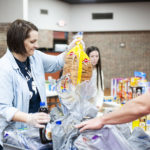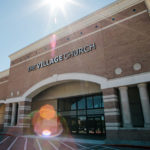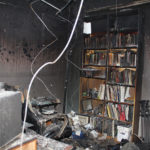As churches that suspended public gatherings due to the COVID-19 pandemic consider reopening their buildings, some Texas Baptists with extensive experience in church facilities offer recommendations for congregations to keep in mind.
Mold presents a potential problem churches should address, said Tom Elliott, who leads the church builders for Texas Baptist Men.
“Anything that holds water—such as toilets, p-traps, water heaters, baptisteries, floor drains, air conditioning drain lines and drain pans—are places where mold can grow,” Elliott said. “Due to the lack of circulation, water can become stagnant, smell and cause mold to form.”
If floor drains and p-traps beneath sinks lose their water seal, it can cause sewer gases to enter a building, he noted. And if mold forms in air-conditioning drain lines, it can cause drains to become clogged and possibly overflow, causing damage, he noted.
“If HVAC systems were not running during the shutdown, then condensation might be a problem,” Elliott said.
As temperatures rise, condensation particularly can become a problem in metal buildings, and they should be monitored closely for any moldy odors or observable damp spots on walls and ceilings, he suggested.
“Water fountains should be flushed out. Ice makers should be cleaned, filters changed and restarted,” Elliott said.
“Flushing toilets, opening faucets and hose bibs and letting them run for several minutes, spraying the inside of toilet tanks with bleach, pouring a gallon of water down floor drains and cleaning out air-conditioning lines should take care of most concerns.”
Walk through the facility
Considering the relatively brief time church buildings have been closed due to the pandemic, most facilities should not experience significant problems, said Keith Crouch, director of Texas Baptists’ church architecture team, and church architecture consultant Ken Hunnicutt, who formerly served as business administrator at Green Acres Baptist Church in Tyler, First Woodway Baptist Church in Waco and First Baptist Church in Weatherford.
Sign up for our weekly edition and get all our headlines in your inbox on Thursdays
However, they suggested church leaders conduct a walk-through of the facility to ensure that lighting, plumbing and cooling systems are working properly. Routine maintenance service of air-conditioning systems and plumbing might be in order, they noted.
They also recommended reviewing signage to make sure it is appropriate and evaluating the facility in terms of its appearance.
Clear clutter from hallways and fire exits, and ensure any necessary mowing or trimming on the church property has been completed before members and guests return, they suggested.
In terms of public safety, governing authorities also may have specific recommendations regarding the cleaning of facilities and appropriate practices to encourage continued social distancing, they noted.
Revised guidelines issued from the state
Revised guidelines for houses of worship jointly issued by Gov. Greg Abbott and State Attorney General Ken Paxton on April 21 stated, “Houses of worship should conduct as many activities as possible remotely, and should follow federal guidelines when providing services in person.”
An updated version of the revised guidelines issued April 27 continued to encourage houses of worship to offer as many activities remotely as possible, but it also outlined “minimum health protocols” when providing in-person services.
Both sets of guidelines underscore Abbott’s executive order declaring religious services conducted in houses of worship as “essential services,” and they specifically state, “Local governments may not order houses of worship to close.” At the same time, the guidelines emphasize the state’s compelling interest to stop contagion and protect public health.
For churches and other houses of worship that choose to conduct public services, the state officials recommended these minimum health protocols:
- Strongly encourage individuals in at-risk populations to participate in worship remotely.
- Designate an area in the facility reserved exclusively for the at-risk population, or offer a service open only to the at-risk population.
- Ensure proper spacing between worshippers who attend—with at least six feet between parties in any row. Individuals in the same household or individuals attending worship together can sit adjacent to each other, provided they keep six feet between themselves and others. Keep every other row empty.
State officials issued the following protocols for employees and volunteers:
- Provide training on appropriate cleaning and disinfection, hand hygiene and respiratory etiquette. They should wash or sanitize their hands upon entering the facility, and they should maintain six feet separation from others. Consider having employees and volunteers wear face covering over the nose and mouth.
- Screen employees and volunteers before they enter a place of worship, sending home any who exhibit new or worsening signs of COVID-19, including cough, shortness of breath or difficulty breathing, chills and shaking, muscle pain, headache, sore throat, loss of taste or smell, diarrhea or a body temperature 100 degrees or greater, as well as anyone who has been in close contact with a confirmed case of COVID-19.
- Any volunteer or employee who has been diagnosed with COVID-19 must meet three criteria before returning to a house of worship: at least 72 hours fever-free, improved respiratory symptoms and at least seven days have passed since symptoms first appeared. If a person has symptoms and has not been tested and evaluated by a medical professional but wishes to return to work before completing the self-isolation period, he or she must have a note from a medical professional.
- Any employee or volunteer who has had known close contact with a person who has a confirmed case of COVID-19 must complete a 14-day self-quarantine from the last date of exposure.
The state officials also issued health protocols for facilities:
- Regularly and frequently clean and disinfect regularly touched surfaces.
- Disinfect seats between services and any items that come into contact with attendees.
- Make hand sanitizer, disinfecting wipes, soap and water, or other disinfectant readily available.
- Post readily visible signs reminding everyone of best hygiene practices.
- If meals are provided, it is recommended that they be individually packaged.
- Maintain rigorous sanitation practices such as disinfection, handwashing and cleanliness when preparing or serving anything edible.
“Churches, congregations, and houses of worship may adopt additional protocols consistent with their specific needs and circumstances to help protect the health and safety of all Texans,” the guidelines state. “The same minimum standard health protocols would apply to funeral services, burials and memorials.”
Editor’s Note: The article was edited less than three hours after it originally was posted on April 27 to include updated guidelines from the governor and attorney general.














We seek to connect God’s story and God’s people around the world. To learn more about God’s story, click here.
Send comments and feedback to Eric Black, our editor. For comments to be published, please specify “letter to the editor.” Maximum length for publication is 300 words.